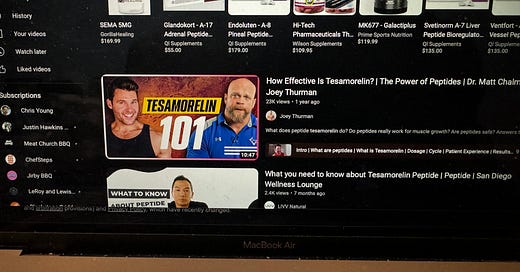It seems about once a decade, there’s a hot new drug around sports. Sometimes it’s legal, most times it’s not, but there’s always the grey area that can get very interesting. We’ve gone from BALCO to Biogenesis, but the last decade has shown just how a serious, focused drug testing program can stave off the kind of innovation we normally see.
The latest craze we’re seeing in baseball is the use of compounded peptides. Peptides are a huge growth area, including drugs like Ozempic and Mounjaro, but it’s also a very broad category of drugs that can be used for everything from diabetes to weight loss, from hormonal controls to bodybuilding, and putting them together fits right into the biohacking community’s longstanding love of compounding. Compounding is where a speciality pharmacy, now easily accessible on the internet, can put together a “biosimilar” drug, even putting two or three into the same injection - a “peptide stack.”
One peptide that’s seeing increased usage is tesamorelin. Designed and approved for use in HIV patients for wasting, the function of the peptide increase growth hormone and insulin growth factor, two powerful anabolic agents. The drug has been used outside of purpose for everything from simply adding mass to trying to accelerate healing after surgery, though there’s no credible study showing it would assist with that, especially in ligaments.
While the drug, approved as Egrifta, is available by prescription, compounding pharmacies often aren’t as concerned or are associated with a telemedicine doctor who is all too happy to write a script. (Not all telemedicine is bad, mind you, but it’s an area where the unscrupulous can find an easier route to their goal, which is usually taking your money more than healing a condition.) One company, Concierge MD, told Semafor that they’d seen 350 percent growth recently, following mentions on podcasts by Joe Rogan and Andrew Huberman.
In some Latin American countries, where drug access is often far different than in the US and Canada, drugs and compounds are very easy to come by, even as prescriptions for drugs like Ozempic are hard to fill due to massive demand. Again, this is where the compounders can make hay filling the gap. For a baseball player trying to return from surgery, or a 14-year-old hoping to be signed in a year, the bad advice of a buscone or the need for a shortcut will have them doing everything, including the use of a peptide at the very least.
The World Antidoping Agency (WADA) has peptides classified as growth hormone releasing hormones like tesamorelin on the banned list, it’s extremely difficult to detect with current tests. There have been no positive tests, but there has been some admission of use, though I couldn’t find out what sports these came in.
There’s an even bigger risk with some of these. Just as many drugs like BALCO’s “clear” come from older, unapproved drugs, peptides that didn’t make it through the FDA or EU process are being sold on the black and grey markets. One such peptide, GW1516 or endurable, has been detected in sport. That drug was stopped from human trials because it was found to cause cancer in lab animals. Even with that, the drug is still easily found for sale with a web search.
This is what I saw on a simple search for “tesamorelin” on YouTube, a Google property. You can not only see a number of videos purporting to show use of the drug, with several offering it for sale, there’s also ads for steroids above in the approved space. Not only are several banned in sport and illegal for sale, but there’s no guarantee that what you buy is what you get.
(Man, I watch a lot of BBQ videos ...)
With the class of peptides on the WADA list, they’re automatically added to MLB’s Joint Drug Agreement banned list under section 2F. MLB has gone further, adding tesamorelin specifically in the last update, adding to the “HGH, secretagogues, and peptides” section (72) in more detail. Again, the difficulty in detection is problematic, but it’s nice to see MLB being proactive.
Again, there are no known positives in pro baseball, but there’s no testing at lower levels and most done even at the collegiate levels are pretty low quality, looking for simple anabolic steroids and drugs of abuse. The lack of testing, even at showcase events with a low number of athletes, remains a disturbing reality and when an athlete hears he isn’t big enough or doesn’t throw hard enough, you can see what a web search might turn up.
There’s always going to be players motivated to use illegal substances, given the money and pressure of performance. There’s always going to be new drugs, often miraculous drugs designed for one thing that are found to be useful in another. Add in the grifter culture in the world and there’s bound to be a new Anthony Bosch somewhere, probably with a podcast.
Anytime I write about drugs, I’m always torn between showing a lot of information and links, and worrying that it becomes a template for someone looking for these drugs. I wrote an April fool’s article at Baseball Prospectus years ago talking about a cure for labrum issues and to this day, despite a bold disclaimer at the top, I still get emails asking for more information. I hope I’ve found a balance.






You’re welcome Will. I was thinking, is there any way you could offer a gift subscription in my name next month and give it to a deserving person of your choice? I’d like to think there are other long time subscribers who’d be interested in “pledging” a gift subscription in this manner as well. Just thinking out loud🙂👍⚾️
Just another high quality, informative post from you Will. As always thank you and please keep grinding!🙂👍⚾️